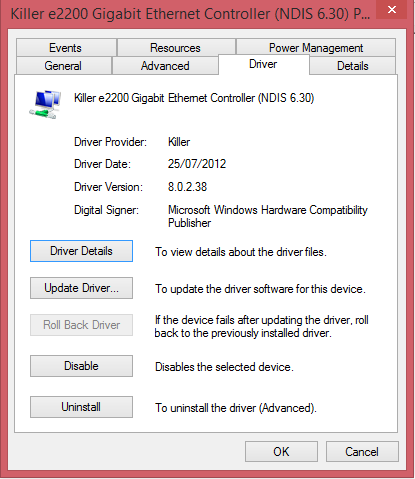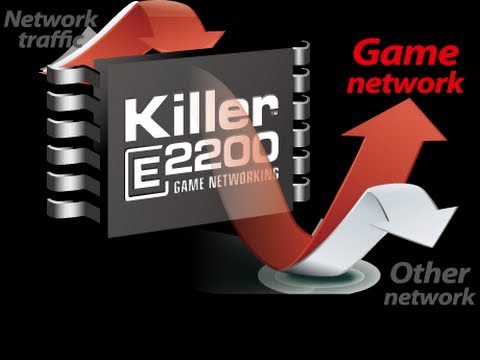Killer E2200 Ethernet
The Killer ™ E2500, the latest in Rivet Networks’ award-winning line of Killer Gigabit Ethernet Controllers, sets a new standard for network performance and control by delivering powerful new technology that detects and optimally prioritizes your games, video, and chat applications. The E2500 also features the all-new Killer Control Center which gives users full control of all aspects of. Killer Wireless-N 1202 and E2200 Ethernet controller launch, aim to squash your ping times Latest in Gaming Xbox Series X and PS5: The new consoles are all about crazy fast storage. There are three different methods available for you to install the Killer Ethernet E2200 driver only on Windows 7, 8, 10 32-bit or 64-bit. You can select one suits your case. Before you get deeper, it is a necessity for you to connect to the wired network in order to install the Killer network driver. QualComm Killer e2200 Ethernet Adapter Free Driver Download. Version New File Size: Network Devices Supported OS: All downloads available on this website have been scanned by the latest anti-virus software and are guaranteed to be virus and malware-free. They add hundreds of new drivers to our site every day. The Killer ™ E2600 is the latest product in Rivet Networks’ award-winning line of Gigabit Ethernet Controllers. By delivering Killer’s most advanced networking features with the latest gigabit Ethernet technology, the E2600 is the ideal choice for gamers and PC enthusiasts who want the best gigabit network connectivity in their PCs.
- - Purity Sound™
- HDMI-In
- ASRock Cloud - CPU Power
- Hi-Density Power Connector
VGA Card
- 15μ Gold Finger in VGA PCIe Slot (PCIE2)
- SLI/CrossFireX™ Power Connector
Internet
- Qualcomm® Atheros® Killer™ LAN
Audio
- Purity Sound™ - - Supports New 4th and 4th Generation Intel® Xeon® / Core™ i7 / i5 / i3 / Pentium® / Celeron® Processors (Socket 1150)
- Digi Power design
- 8 Power Phase design
- Supports Intel® Turbo Boost 2.0 Technology
- Supports Intel® K-Series unlocked CPUs
- Supports ASRock BCLK Full-range Overclocking - - Intel® Z87
- - Dual Channel DDR3/DDR3L Memory Technology
- 4 x DDR3/DDR3L DIMM Slots
- Supports DDR3/DDR3L 3050+(OC)/2800(OC)/2400(OC)/2133(OC)/1866(OC)/1600/1333/1066 non-ECC, un-buffered memory
- Max. capacity of system memory: 32GB*
- Supports Intel® Extreme Memory Profile (XMP) 1.3 / 1.2*Due to the operating system limitation, the actual memory size may be less than 4GB for the reservation for system usage under Windows® 32-bit OS. For Windows® 64-bit OS with 64-bit CPU, there is no such limitation. - - 2 x 64Mb AMI UEFI Legal BIOS with multilingual GUI support (1 x Main BIOS and 1 x Backup BIOS)
- Supports Secure Backup UEFI Technology
- ACPI 1.1 Compliant wake up events
- SMBIOS 2.3.1 support
- CPU, DRAM, PCH 1.05V, PCH 1.5V Voltage multi-adjustment - - Supports Intel® HD Graphics Built-in Visuals : Intel® Quick Sync Video with AVC, MVC (S3D) and MPEG-2 Full HW Encode1, Intel® InTru™ 3D, Intel® Clear Video HD Technology, Intel® Insider™, Intel® HD Graphics 4400/4600
- Pixel Shader 5.0, DirectX 11.1
- Max. shared memory 512MB*
- Multi Graphics Output Options: D-Sub, DVI-D and HDMI Ports
- Supports Triple Monitor
- Supports HDMI Technology with max. resolution up to 4K x 2K (4096x2304) @ 24Hz
- Supports DVI-D with max. resolution up to 1920x1200 @ 60Hz
- Supports D-Sub with max. resolution up to 1920x1200 @ 60Hz
- Supports Auto Lip Sync, Deep Color (12bpc), xvYCC and HBR (High Bit Rate Audio) with HDMI Port (Compliant HDMI monitor is required)
- Supports HDCP with DVI-D and HDMI Ports
- Supports Full HD 1080p Blu-ray (BD) playback with DVI-D and HDMI Ports*The size of maximum shared memory may vary from different operating systems.
**Intel® HD Graphics Built-in Visuals and the VGA outputs can be supported only with processors which are GPU integrated.
***Due to chipset limitation, the Blu-ray playback of Intel® HD Graphics is only supported under Windows® 8 / 8 64-bit / 7 / 7 64-bit / Vista™ / Vista™ 64-bit.
****Intel® InTru™ 3D is only supported under Windows® 8 / 8 64-bit / 7 / 7 64-bit. - - 7.1 CH HD Audio with Content Protection (Realtek ALC1150 Audio Codec)
- Premium Blu-ray Audio support
- Supports Purity Sound™
- 115dB SNR DAC with differential amplifier
- TI® NE5532 Premium Headset Amplifier (Supports up to 600 ohm headsets)
- Direct Drive Technology
- EMI shielding cover
- PCB isolate shielding
- Supports DTS Connect - - PCIE x1 Gigabit LAN 10/100/1000 Mb/s
- Qualcomm® Atheros® Killer™ E2200 Series
- Supports Wake-On-LAN
- Supports Energy Efficient Ethernet 802.3az
- Supports PXE - - 3 x PCI Express 3.0 x16 Slots (PCIE2/PCIE5/PCIE7: single at x16 (PCIE2); dual at x8 (PCIE2) / x8 (PCIE5); triple at x8 (PCIE2) / x4 (PCIE5) / x4 (PCIE7))
- 4 x PCI Express 2.0 x1 Slots
- Supports AMD Quad CrossFireX™, 3-Way CrossFireX™ and CrossFireX™
- Supports NVIDIA® Quad SLI™ and SLI™ - - 6 x SATA3 6.0 Gb/s Connectors, support RAID (RAID 0, RAID 1, RAID 5, RAID 10, Intel® Rapid Storage Technology 12 and Intel® Smart Response Technology), NCQ, AHCI and Hot Plug
- - 1 x IR Header
- 1 x COM Port Header
- 1 x Power LED Header
- 2 x CPU Fan Connectors (1 x 4-pin, 1 x 3-pin)
- 3 x Chassis Fan Connectors (1 x 4-pin, 2 x 3-pin)
- 1 x Power Fan Connector (3-pin)
- 1 x 24 pin ATX Power Connector
- 1 x 8 pin 12V Power Connector (Hi-Density Power Connector)
- 1 x SLI/XFire Power Connector
- 1 x Front Panel Audio Connector
- 2 x USB 2.0 Headers (Support 4 USB 2.0 ports)
- 1 x USB 3.1 Gen1 Header (Supports 2 USB 3.1 Gen1 ports) - - 1 x PS/2 Mouse/Keyboard Port
- 1 x D-Sub Port
- 1 x DVI-D Port
- 1 x HDMI-Out Port
- 1 x HDMI-In Port
- 1 x Optical SPDIF Out Port
- 3 x USB 2.0 Ports
- 1 x Fatal1ty Mouse Port (USB 2.0)
- 4 x USB 3.1 Gen1 Ports
- 1 x RJ-45 LAN Port with LED (ACT/LINK LED and SPEED LED)
- HD Audio Jacks: Rear Speaker / Central / Bass / Line in / Front Speaker / Microphone - - ASRock F-Stream
- ASRock APP Shop
- ASRock Instant Flash
- ASRock APP Charger
- ASRock XFast USB
- ASRock XFast RAM
- ASRock Crashless BIOS
- ASRock OMG (Online Management Guard)
- ASRock Internet Flash
- ASRock UEFI System Browser
- ASRock UEFI Tech Service
- ASRock Dehumidifier
- ASRock Easy RAID Installer
- ASRock Easy Driver Installer
- ASRock Interactive UEFI
- ASRock Fast Boot
- ASRock Restart to UEFI
- ASRock USB Key
- ASRock Key Master
- ASRock FAN-Tastic Tuning
- Hybrid Booster:
- CPU Frequency Stepless Control
- ASRock U-COP
- Boot Failure Guard (B.F.G.)
- Good Night LED - - Drivers, Utilities, AntiVirus Software (Trial Version), Google Chrome Browser and Toolbar, Start8 (30 days trial), XSplit, Killer Network Manager
- - 1 x ASRock SLI_Bridge_2S Card
- Quick Installation Guide, Support CD, I/O Shield
- 4 x SATA Data Cables - - CPU, Chassis temperature sensing
- CPU, Chassis, Power Fan Tachometer
- CPU, Chassis Quiet Fan (Auto adjust fan speed by CPU temperature)
- CPU, Chassis Fan multi-speed control
- Voltage monitoring: +12V, +5V, +3.3V, CPU Vcore Voltage - - ATX Form Factor
- Premium Gold Capacitor design (100% Japan made high quality conductive polymer capacitors) - - Microsoft® Windows® 10 64-bit / 8.1 32-bit / 8.1 64-bit / 8 32-bit / 8 64-bit / 7 32-bit / 7 64-bit
- - FCC, CE
- ErP/EuP ready (ErP/EuP ready power supply is required)
If your Internet connection seems slow for any reason, your first steps should be to clean install the Killer Control Center, which includes the latest device drivers, then reset your networking device and network stack.
You may find that your Ethernet speed is capped at 100 Mbps when your Internet Service Provider, or your internal network connection, should be providing speeds higher than 100 Mbps. If this is the case, and you have already tried the two guides above, then you may be encountering a link speed issue. To check for this, check the link speed on the machine in question by following these steps:
- Search Control Panel with Windows Search and press Enter
- Click Network and Internet
- Click View network status and tasks which will be underneath Network and Sharing Center
- Click the connection that represents the Ethernet connection to your router or modem. You should see a screen that looks something like this.
Notice that the link “Speed” here reads as 100 Mbps. This means that the negotiated connection speed between the Ethernet adapter and whatever device it is plugged into is 100 Mbps. When everything is working correctly, this speed will read as 1.0 Gbps.
The only setting that is of concern for a Gigabit connection is that the adapter is set to Auto Negotiation. From the Device Manager, you can check to see that the Killer adapter is set on Auto Negotiation. This option is under the Advanced tab of the adapter’s properties, in Speed & Duplex – right-click the adapter and choose properties, click the Advanced tab, and click Speed & Duplex, and make sure it is set to Auto Negotiation. This is the default setting.
We have had reports of some ISP technicians telling their customers that a Gigabit option will appear in this setting if the network adapter is working correctly. This is incorrect. Auto Negotiation is the correct setting for Gigabit speeds in Speed & Duplex for Killer Networking Adapters. There is no option for 1.0 Gbps Full Duplex with our Ethernet drivers. Auto Negotiation will give you a 1.0 Gbps link speed, provided your other networking equipment auto-negotiates correctly.
If this is set correctly and your link speed still reads as 100 Mbps, then the issue could be a few things, although it is important to note up front that this is almost always an issue with an Ethernet cable.
Before troubleshooting any further, check the connection of the Ethernet cable into every piece of networking equipment, as well as your computer. Make sure each cable is labeled Cat 6 or Cat7. Unplug each Ethernet cable and plug it back in. Make sure that your cable is pressed firmly into the Ethernet jack. You should hear and feel a very audible click sound when the cable is in place. If you do not feel and hear this, then this cable should be considered broken, and you need to replace it.
Even if you firmly believe that your Ethernet cabling is perfectly fine, and even if this cabling worked fine before, swapping it out for another, proven cable, or a brand new Cat 6 cable, will almost certainly solve the issue with the minimum of troubleshooting and headache. This is a very, very common occurrence when troubleshooting Gigabit Ethernet, and it nearly always comes down to one cable being the culprit. Note that this includes all cabling between the machine and the router, including any cabling in before and after any switches, or on the other side of any wall jacks, and behind the wall. However, if you were getting Gigabit using a particular setup and suddenly, with no changes whatsoever, your link speed is now 100 Mbps, then it’s probably only one cable that is currently having issues, and it is likely one that is exposed.

The fastest way to rule out any problems with anything other than cabling is to connect your machine directly into your modem with a single, proven Cat 6 or better Ethernet cable, and preferably into a proven Gigabit-capable port, then check the link speed. If the link speed shows as 1.0 Gbps, then you know that the problem is somewhere in what you have just bypassed. Using this method of troubleshooting can be a pain if you are not dealing with a laptop, but it might still be worth doing if you have to decide if you need to call a contractor out to look at wiring behind your walls. Note that very long Ethernet cords are available for purchase, with lengths of over 200 feet or 60 meters, are available, so if you are involved in a prolonged debate with a technician over link speeds, this might be the simplest way to provide a temporary, single cable connection from your machine to the modem.
That said, all adapters are different and handle shorts or issues with cables or ports differently, but a Gigabit adapter reporting as 100 Mbps is almost certainly a physical issue with the networking equipment.

You can troubleshoot this by trying different combinations:
- If you cannot connect your machine to the modem with a single, proven Cat 6 cable, maybe you can connect a computer whose link speed currently shows as 1 Gbps to the Ethernet cable that is currently plugged into the problem machine. If this second machine now displays a link speed of 100 Mbps, this also proves that the issue is somewhere in the cabling or equipment between the computer and the access point, not with the machine itself.
- Power cycle (unplug and plug back in) your access point (hub, switch, router) and any other device between your machine and the access point.
- Cat 6 is preferred to Cat 5e as, although the latter is technically capable of gigabit connections, it lacks any redundancies in grounding, which is a common point of failure in network cables. Cat 6 remedies this issue, and making sure that all of your cabling is Cat 6 or better is usually a surefire way to achieve a gigabit connection.
- A “failed” Cat 5e or Cat 6 cable will usually still work at 100 Mbps. It doesn’t take much physical trauma for a Cat 5e cable to revert to 100 Mbps, and many of the cheaper ones don’t support 1 Gbps out of the bag, even though they will be labeled as supported 1 Gbps connections. If you have only tried a Cat 5e cable, you owe it to yourself to try a Cat 6 cable. This is almost certainly the issue. If you are having problems achieving Gigabit speeds and you have Cat 5e cables in the mix, then it is safe to assume that those specific Cat 5e cables are not Gigabit capable. This is common. Incidents such as rolling over the cable with an office chair, or stepping on it, or closing a door on it, can all cause a Cat 5e cable to revert to 100 Mbps link speeds when it was previously working at Gigabit speeds.
- Try different ports on your access point (hub, switch, router). If possible, use a port that is proven capable of working at Gigabit speeds with another machine.
- If all of these fail, then likely the Ethernet connector on the mainboard has an issue, and you would need to check with your PC manufacturer (or mainboard manufacturer, if you assembled the machine yourself) on what your warranty or RMA options are. You may want to perform a physical inspection on the Ethernet jack’s pins to make sure that none of them are bent or otherwise damaged. It is worth stressing once more, though, that this issue is nearly always one with the cabling somewhere between the Ethernet jack on your machine, and the Ethernet jack for the modem.
Was this article helpful?
Related Articles
Killer E2600 Gigabit Ethernet Controller
CONTACT SUPPORT